Evaluating Unplug Incentives to Improve User Experience and Increase DC Fast Charger Utilization
Abstract
1. Introduction
1.1. Background
1.2. Literature Review
1.3. Structure of Paper and Novelty
2. Modeling and Methods
2.1. Unplug Incentives
2.2. Model and Variable Description
- Arrivalt of vehicles, an incrementing integer is assigned to the appropriate location within a timeseries vector. The integer value is the number of vehicles that have arrived up to that point in time, while the location within the timeseries corresponds to the time of arrival.
- Abandon charging; If a vehicle arrives and the cordset is occupied, there is a chance (described in Section 3.5) that it will abandon this attempt and move on to some other charger or destination (termed ‘balking’ in [29,37]). This is an incrementing integer.
- Starting SoCn, Ending SoCn, and Battery Typen are three vectors each having a length corresponding to the arrival number, such that they grow throughout the modeled year. Each arriving vehicle is probabilistically assigned a battery type and a starting and ending SoC, based on observed distributions of those parameters.
- Duration is an integer variable tracking the number of minutes from the start of each charging session. It resets with each new session.
- Queue is tracked in a vector of varying length. The arrival number of each new vehicle is appended to the end of the vector, while that of a vehicle concluding its charging session and departing is deleted from the front. All vehicles at the site are listed in the Queue, including the one charging. (While including the charging vehicle in the Queue may not align intuitively with the meaning of the word, it simplifies coding).
- Queue Lengtht is a timeseries vector tracking how many vehicles are at this site, including the one charging.
- Session Count is an integer that increases when a vehicle in the Queue connects to the cordset and starts charging.
- Occupiedt is a timeseries logic-valued vector, simply indicating whether a vehicle is at the cordset at each point in time.
- SoCt and Powert are timeseries vectors that reflect the interaction between the cordset and the sequence of charging vehicles. They both have a default value of zero (0). When a vehicle is charging, SoCt is the state of charge of the charging vehicle, and Powert is the charging power in kW, which is the lesser of the cordset power limit (175 kW) or the value corresponding to the SoC and the charging curve of that battery type.
- Forced Off is an incrementing 1 × 2 vector that tracks the number of instances of the unplug incentive being invoked. When it is invoked and there is another vehicle waiting in the Queue, the first value, termed ‘beneficial’, is increased. If there are no vehicles waiting in the Queue, the second value, termed ‘needless’, is increased.
2.3. Timeseries Model
- The Arrival of an EV seeking charging:
- This is evaluated probabilistically based on the hour of the day and the day type (weekday or weekend day). These probabilities, observed from source data (see Section 3.1), are multiplied by a range of factors between 0 and 16 to produce representations of different site popularities between 0 and ~23,000 EVs seeking charging per year. Site popularity for each multiplication factor is defined as the number of vehicles found to arrive at the site per year at the end of the model run (i.e., the site popularity is observational, not prescriptive).
- When a vehicle arrives, its Battery Typen, Starting SoCn, and intended Ending SoCn are assigned probabilistically, based on observed data and expectations of future market evolution (see Section 3.3 and Section 3.4).
- Based on the Starting SoCn and the length of the Queue, the arriving EV ‘decides’ to either join the Queue, or if the Queue is too long, to Abandon the attempt (see Section 3.5). Any vehicle arriving with less than 20% Starting SoCn will not Abandon.
- Any vehicle that does not Abandon joins the Queue (even if it is the only vehicle present).
- A vehicle from the Queue starts charging:
- If there is one or more vehicles in the Queue, and the cordset has not been Occupiedt for 3 or more minutes (a number chosen based on observations of lag between charging events, described in greater detail in [23]), then the first vehicle in the Queue starts charging.
- Increment Session Count by one.
- Charging is taking place:
- If the cordset is Occupiedt by a vehicle, charging is occurring.
- The Powert of charge is the lesser of that allowable by the charger (set to 175 kW in this model), and the power allowable by the battery, which is a function of the Battery Typen and the SoCt (see Section 3.2).
- Update the battery’s SoCt for this timestep based on the value of SoCt in the previous timestep, the Battery Typen capacity, and the charging Powert in this timestep.
- A vehicle terminates its charging session and leaves:
- Compare SoCt vs. this vehicle’s intended Ending SoCn or
- Determine if this timestep is one of the ‘peak hours’ (see Section 3.1), and one of either Powert vs. trigger power limit, SoCt vs. trigger SoC limit, or the Duration of this session vs. trigger duration limit. A vehicle with a SoCt of less than 20% in this timestep will not terminate early.
- If any of these apply, remove this vehicle’s Arrival number from position 1 of the Queue, and increment the count of either ‘needless’ or ‘beneficial’ Forced Off events, depending on whether there is another vehicle waiting in the Queue or not.
3. Data Sources and Observed EV Characteristics and Behavior
3.1. Probability of an EV Arriving
3.2. Representative Charging Curves
3.3. Battery Type
3.4. Charging Needs of Each Individual Vehicle
- (i).
- Data suspected of reflecting a Plug-in Hybrid Electric Vehicle were excluded. These were identified by a small battery (less than 45 kWh), and in isolation, had a high prevalence of starting SoC values very near 0%. Such vehicles have generators/range extenders, and are able to completely deplete their batteries with no negative operational impacts. It was surmised that while such small-battery vehicles might charge at relatively low cost, low-power 50 kW units used as source data would be unlikely to charge at the higher-power, higher-cost 175 kW units being modeled, due to the inability of most hybrid models to make use of such high powers.
- (ii).
- Charging events of vehicles with a computed battery capacity > 95 kWh were excluded. Such vehicles, charging on NSPI’s 50 kW chargers, would be most likely to charge the minimum amount possible to reach another destination, i.e., a 50 kW charger would take 1 h or more to significantly charge a 100+ kWh battery. It was deemed that user behavior of such vehicles at a 50 kW charger would be materially different from their behavior at the 175 kW chargers modeled in this study. Such vehicles, in isolation, showed a tendency to have an ending SoC relatively close to their starting SoC, indicating frustration with relatively slow charging.
3.5. Abandoning This Charger for Another Due to Queue
3.6. Model Validation
4. Results
- Charging Power (left plots), under which a user would disconnect once the charging rate falls below a specified power (kW). Increasing the power limit (moving up in the plot) reflects a more restrictive tariff, while the null hypothesis is reflected at y = 0 kW.
- Battery SoC (middle plots), under which a user would disconnect once their vehicle reaches a specified SoC (%). A lower maximum SoC threshold value (moving down in the plot) produces a more restrictive tariff, while the null hypothesis is reflected at y = 100% SoC.
- Charging session Duration (right plots), under which a user would disconnect after charging for a specified charging Duration (minutes). A lower threshold value (moving down in the plot) produces a more restrictive tariff, while the null hypothesis is reflected at y = ∞ minutes. For plotting purposes, the y-axis value of the null hypothesis is 70 min.
4.1. Sessions Terminations Due to Disconnect Incentive
4.2. Occupancy and Abandonment
4.3. Energy Sales
4.4. User Experience—Wait Times
4.5. Compound Metric
5. Discussion
5.1. Comparisons of Different Trigger Metrics’ Preferred Ranges
5.2. Non-Technical Considerations on the Selection of a Trigger Metric
5.3. Smart Solutions
5.4. Generalizability of These Findings
6. Conclusions and Policy Implications
Author Contributions
Funding
Data Availability Statement
Acknowledgments
Conflicts of Interest
References
- UNFCCC. The Paris Agreement. Available online: https://unfccc.int/process-and-meetings/the-paris-agreement (accessed on 26 February 2025).
- McCollum, D.; Krey, V.; Kolp, P.; Nagai, Y.; Riahi, K. Transport electrification: A key element for energy system transformation and climate stabilization. Clim. Change 2014, 123, 651–664. [Google Scholar] [CrossRef]
- Zhang, R.; Fujimori, S. The role of transport electrification in global climate change mitigation scenarios. Environ. Res. Lett. 2020, 15, 034019. [Google Scholar] [CrossRef]
- Ritchie, H. Tracking global data on electric vehicles. Our World in Data. February 2024. Available online: https://ourworldindata.org/electric-car-sales (accessed on 22 July 2025).
- International Energy Agency. Trends in Electric Car Markets—Global EV Outlook 2025—Analysis. Available online: https://www.iea.org/reports/global-ev-outlook-2025/trends-in-electric-car-markets-2 (accessed on 22 July 2025).
- Beckman, T.N. A brief history of the gasoline service station. J. Hist. Res. Mark. 2011, 3, 156–172. [Google Scholar] [CrossRef]
- ABB Inc. Terra 360. 2022. Available online: https://new.abb.com/ev-charging/terra-360 (accessed on 10 November 2025).
- Bräunl, T.; Harries, D.; McHenry, M.; Wager, G. Determining the optimal electric vehicle DC-charging infrastructure for Western Australia. Transp. Res. Part D Transp. Environ. 2020, 84, 102250. [Google Scholar] [CrossRef]
- Sawant, V.; Zambare, P. DC fast charging stations for electric vehicles: A review. Energy Convers. Econ. 2024, 5, 54–71. [Google Scholar] [CrossRef]
- Hardman, S.; Jenn, A.; Tal, G.; Axsen, J.; Beard, G.; Daina, N.; Figenbaum, E.; Jakobsson, N.; Jochem, P.; Kinnear, N.; et al. A review of consumer preferences of and interactions with electric vehicle charging infrastructure. Transp. Res. Part D Transp. Environ. 2018, 62, 508–523. [Google Scholar] [CrossRef]
- Sierzchula, W.; Bakker, S.; Maat, K.; van Wee, B. The influence of financial incentives and other socio-economic factors on electric vehicle adoption. Energy Policy 2014, 68, 183–194. [Google Scholar] [CrossRef]
- Wolbertus, R.; van den Hoed, R.; Kroesen, M.; Chorus, C. Charging infrastructure roll-out strategies for large scale introduction of electric vehicles in urban areas: An agent-based simulation study. Transp. Res. Part A Policy Pract. 2021, 148, 262–285. [Google Scholar] [CrossRef]
- Šimčák, M.; Frivaldský, M. Influence of over-voltage on LiFePO4 cell and its elements of battery equivalent scheme. Transp. Res. Procedia 2023, 74, 870–875. [Google Scholar] [CrossRef]
- Menye, J.S.; Camara, M.-B.; Dakyo, B. Lithium Battery Degradation and Failure Mechanisms: A State-of-the-Art Review. Energies 2025, 18, 342. [Google Scholar] [CrossRef]
- Li, Y.; Li, K.; Xie, Y.; Liu, J.; Fu, C.; Liu, B. Optimized charging of lithium-ion battery for electric vehicles: Adaptive multistage constant current–constant voltage charging strategy. Renew. Energy 2020, 146, 2688–2699. [Google Scholar] [CrossRef]
- Bitencourt, L.; Dias, B.; Soares, T.; Borba, B.; Quirós-Tortós, J.; Costa, V. Understanding Business Models for the Adoption of Electric Vehicles and Charging Stations: Challenges and Opportunities in Brazil. IEEE Access 2023, 11, 63149–63166. [Google Scholar] [CrossRef]
- Feng, J.; Khan, A.M. Accelerating urban road transportation electrification: Planning, technology, economic and implementation factors in converting gas stations into fast charging stations. Energy Syst. 2024, 1–32. [Google Scholar] [CrossRef]
- Pearre, N.S.; Swan, L.G.; Burbidge, E.; Balloch, S.; Horrocks, L.; Piper, B.; Anctil, J. Regional Electric Vehicle Fast Charging Network Design Using Common Public Data. World Electr. Veh. J. 2022, 13, 212. [Google Scholar] [CrossRef]
- Motoaki, Y.; Shirk, M.G. Consumer behavioral adaption in EV fast charging through pricing. Energy Policy 2017, 108, 178–183. [Google Scholar] [CrossRef]
- Sutton, K.; Hardman, S.; Tal, G. Strategies to Reduce Congestion and Increase Access to Electric Vehicle Charging Stations at Workplaces. April 2022. Available online: https://escholarship.org/uc/item/2345r48k (accessed on 28 July 2025).
- Limmer, S. Dynamic Pricing for Electric Vehicle Charging—A Literature Review. Energies 2019, 12, 3574. [Google Scholar] [CrossRef]
- Kucuksari, S.; Erdogan, N. Cost Analysis of DCFC Fast Charging Station Power Rates for Workplace Charging. In Proceedings of the 2022 IEEE Power & Energy Society Innovative Smart Grid Technologies Conference (ISGT), New Orleans, LA, USA, 24–28 April 2022; pp. 1–5. [Google Scholar] [CrossRef]
- Pearre, N.S.; Swan, L.G. Observational Evaluation of the Maximum Practical Utilization of Electric Vehicle DCFC Infrastructure. World Electr. Veh. J. 2022, 13, 190. [Google Scholar] [CrossRef]
- Cao, Y.; Tang, S.; Li, C.; Zhang, P.; Tan, Y.; Zhang, Z.; Li, J. An Optimized EV Charging Model Considering TOU Price and SOC Curve. IEEE Trans. Smart Grid 2012, 3, 388–393. [Google Scholar] [CrossRef]
- Dong, X.; Mu, Y.; Xu, X.; Jia, H.; Wu, J.; Yu, X.; Qi, Y. A charging pricing strategy of electric vehicle fast charging stations for the voltage control of electricity distribution networks. Appl. Energy 2018, 225, 857–868. [Google Scholar] [CrossRef]
- Singh, G.; D’Arpino, M.; Goveas, T. A Techno-Economic Assessment of DC Fast-Charging Stations with Storage, Renewable Resources and Low-Power Grid Connection. Energies 2024, 17, 4012. [Google Scholar] [CrossRef]
- Ban, D.; Michailidis, G.; Devetsikiotis, M. Demand response control for PHEV charging stations by dynamic price adjustments. In Proceedings of the 2012 IEEE PES Innovative Smart Grid Technologies (ISGT), Washington, DC, USA, 16–20 January 2012; pp. 1–8. [Google Scholar] [CrossRef]
- Roni, M.S.; Yi, Z.; Smart, J.G. Optimal charging management and infrastructure planning for free-floating shared electric vehicles. Transp. Res. Part D Transp. Environ. 2019, 76, 155–175. [Google Scholar] [CrossRef]
- Ucer, E.; Koyuncu, I.; Kisacikoglu, M.C.; Yavuz, M.; Meintz, A.; Rames, C. Modeling and Analysis of a Fast Charging Station and Evaluation of Service Quality for Electric Vehicles. IEEE Trans. Transp. Electrif. 2019, 5, 215–225. [Google Scholar] [CrossRef]
- Liu, B.; Pantelidis, T.P.; Tam, S.; Chow, J.Y.J. An electric vehicle charging station access equilibrium model with M/D/C queueing. Int. J. Sustain. Transp. 2023, 17, 228–244. [Google Scholar] [CrossRef]
- Yang, D.; Sarma, N.J.S.; Hyland, M.F.; Jayakrishnan, R. Dynamic modeling and real-time management of a system of EV fast-charging stations. Transp. Res. Part C Emerg. Technol. 2021, 128, 103186. [Google Scholar] [CrossRef]
- Tan, M.; Ren, Y.; Pan, R.; Wang, L.; Chen, J. Fair and Efficient Electric Vehicle Charging Scheduling Optimization Considering the Maximum Individual Waiting Time and Operating Cost. IEEE Trans. Veh. Technol. 2023, 72, 9808–9820. [Google Scholar] [CrossRef]
- Tesla. Tesla Find Us. Available online: https://www.tesla.com/en_ca/findus? (accessed on 27 September 2024).
- Lambert, F. Tesla Introduces $0.40/Minute Idle Fee for Superchargers to Incentivise Owners to Move When Charging is Over. Electrek. Available online: https://electrek.co/2016/12/16/tesla-supercharger-idle-fees/ (accessed on 11 August 2025).
- Electrify America. Congestion Reduction Effort. Available online: https://www.electrifyamerica.com/soc-pilot/ (accessed on 16 July 2025).
- Lewis, M. A New Electrify America Pilot Will Limit EVs to 85% State of Charge. Electrek. Available online: https://electrek.co/2024/07/08/electrify-america-pilot-state-of-charge-85-percent/ (accessed on 11 August 2025).
- Chattopadhyay, A.; Kar, S. IDEAS: Information-Driven EV Admission in Charging Station Considering User Impatience to Improve QoS and Station Utilization. arXiv 2024, arXiv:2403.06223. [Google Scholar] [CrossRef]
- Jayanath, N.; Pearre, N.S.; Swan, L.G. Geographic Factors Impacting the Demand for Public EV Charging: An Observational Study. World Electr. Veh. J. 2024, 15, 445. [Google Scholar] [CrossRef]
- Pearre, N.S. Location, Duration, and Power; How Americans’ Driving Habits and Charging Infrastructure Inform Vehicle-Grid Interactions. University of Delaware. 2013. Available online: https://www.proquest.com/docview/1511453581?pq-origsite=gscholar&fromopenview=true (accessed on 10 November 2025).
- Li, Z.; Xu, Z.; Chen, Z.; Xie, C.; Chen, G.; Zhong, M. An empirical analysis of electric vehicles ’ charging patterns. Transp. Res. Part D Transp. Environ. 2023, 117, 103651. [Google Scholar] [CrossRef]
- Hecht, C.; Figgener, J.; Sauer, D.U. Analysis of electric vehicle charging station usage and profitability in Germany based on empirical data. iScience 2022, 25, 105634. [Google Scholar] [CrossRef]
- Lee, Z.J.; Li, T.; Low, S.H. ACN-Data: Analysis and Applications of an Open EV Charging Dataset. In Proceedings of the Tenth ACM International Conference on Future Energy Systems, Phoenix, AZ, USA, 25–28 June 2019; ACM: New York, NY, USA, 2019; pp. 139–149. [Google Scholar] [CrossRef]
- Nova Scotia. Electric Vehicle Registration Data|Open Data. Available online: https://data.novascotia.ca/Permits-and-Licensing/Electric-Vehicle-Registration-Data/avxy-ifhs/about_data (accessed on 27 August 2024).
- EVKX.net. EV Models. Available online: https://evkx.net/models/ (accessed on 16 July 2025).
- Fastned. Ultrarapid Charging Stations for Electric Vehicles. Available online: https://www.fastnedcharging.com/en (accessed on 16 July 2025).
- C. Electrique Inc. The Electric Circuit. Available online: http://lecircuitelectrique.com/en/charging/ (accessed on 16 July 2025).
- Cai, W.; Yao, Y.-X.; Zhu, G.-L.; Yan, C.; Jiang, L.-L.; He, C.; Huang, J.-Q.; Zhang, Q. A review on energy chemistry of fast-charging anodes. Chem. Soc. Rev. 2020, 49, 3806–3833. [Google Scholar] [CrossRef]
- Gregory, M. High Power Lithium Ion Battery Characterization. Master’s thesis, Dalhousie University, Halifax, NS, Canada, 2024. [Google Scholar]
- Helmus, J.R.; Lees, M.H.; van den Hoed, R. A data driven typology of electric vehicle user types and charging sessions. Transp. Res. Part C Emerg. Technol. 2020, 115, 102637. [Google Scholar] [CrossRef]

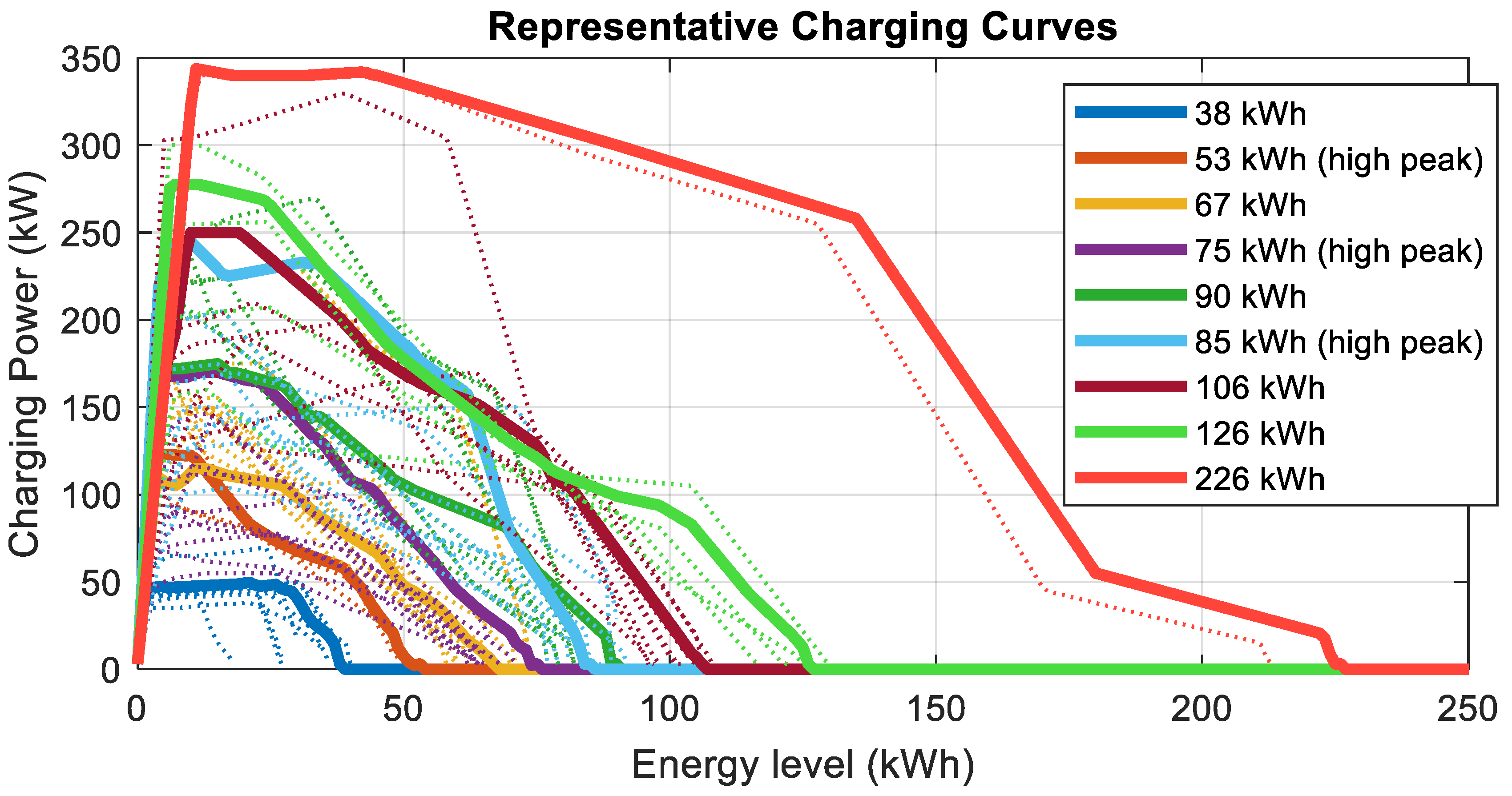
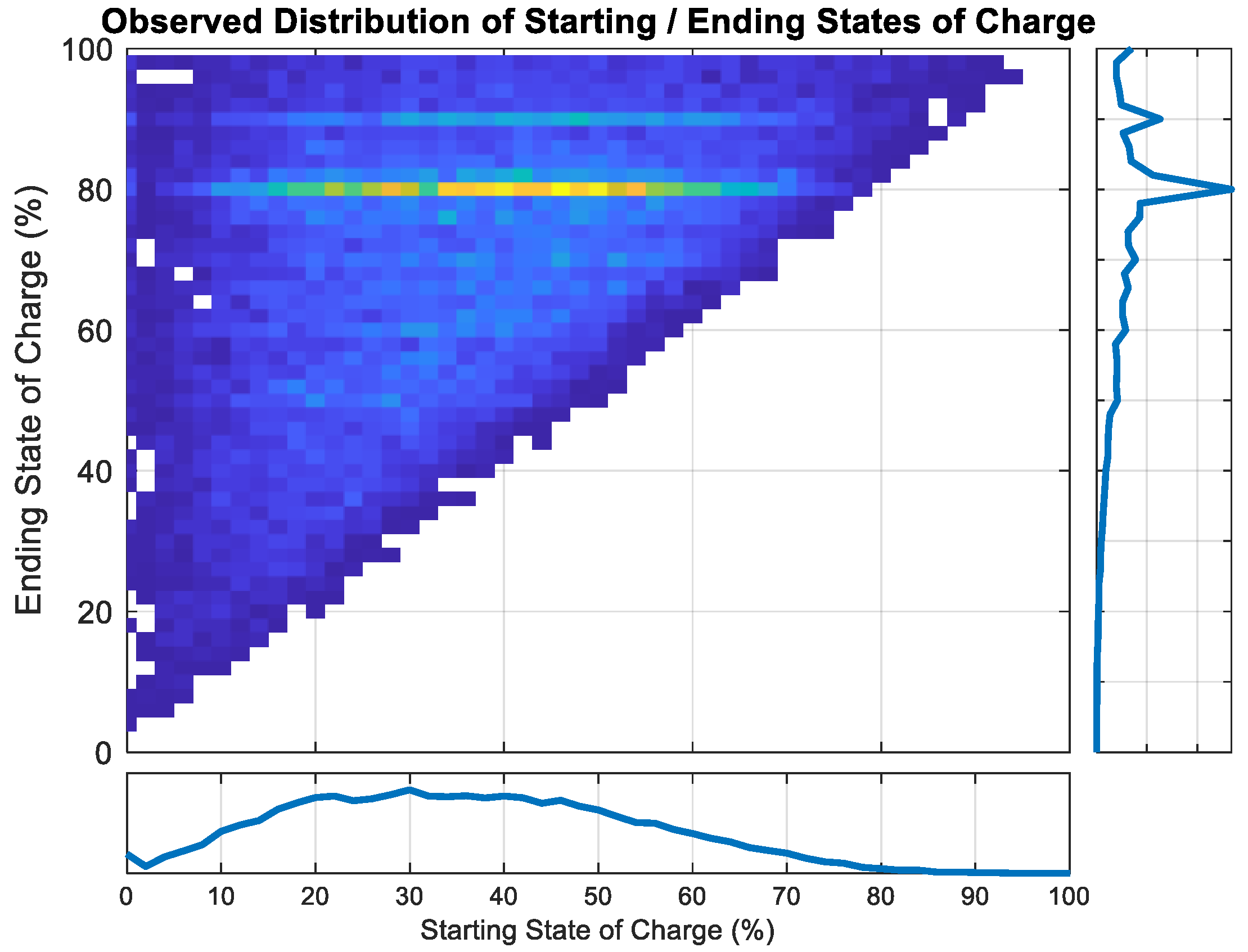





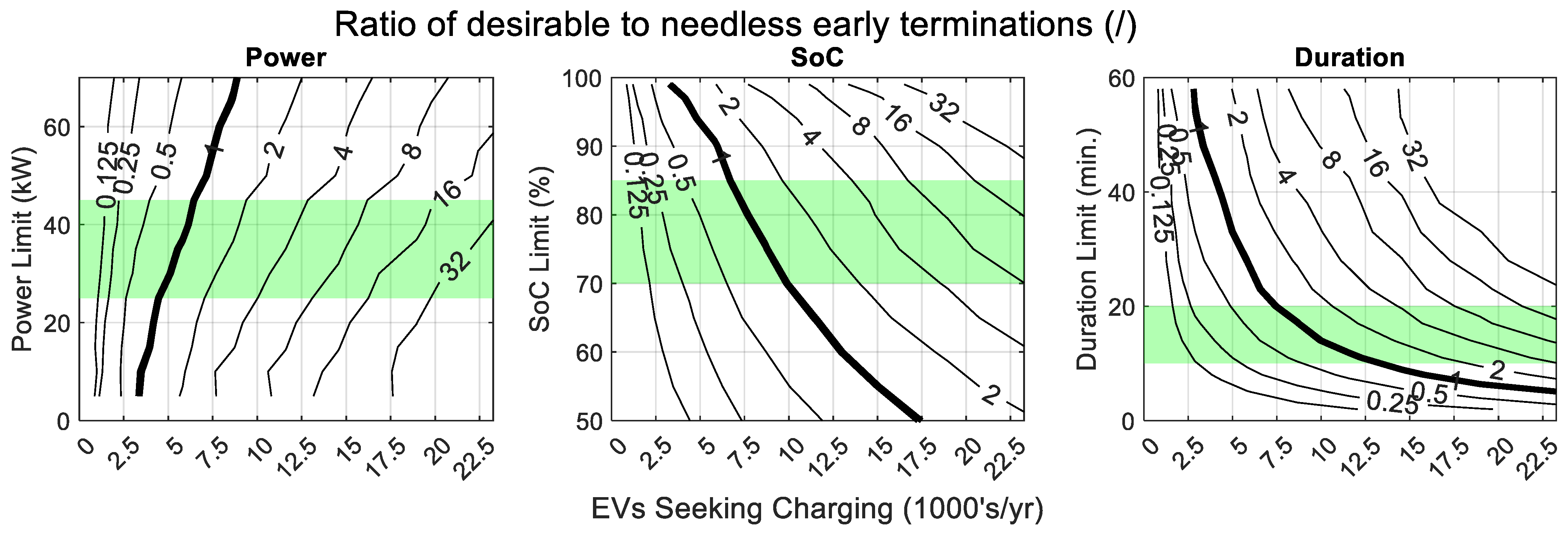
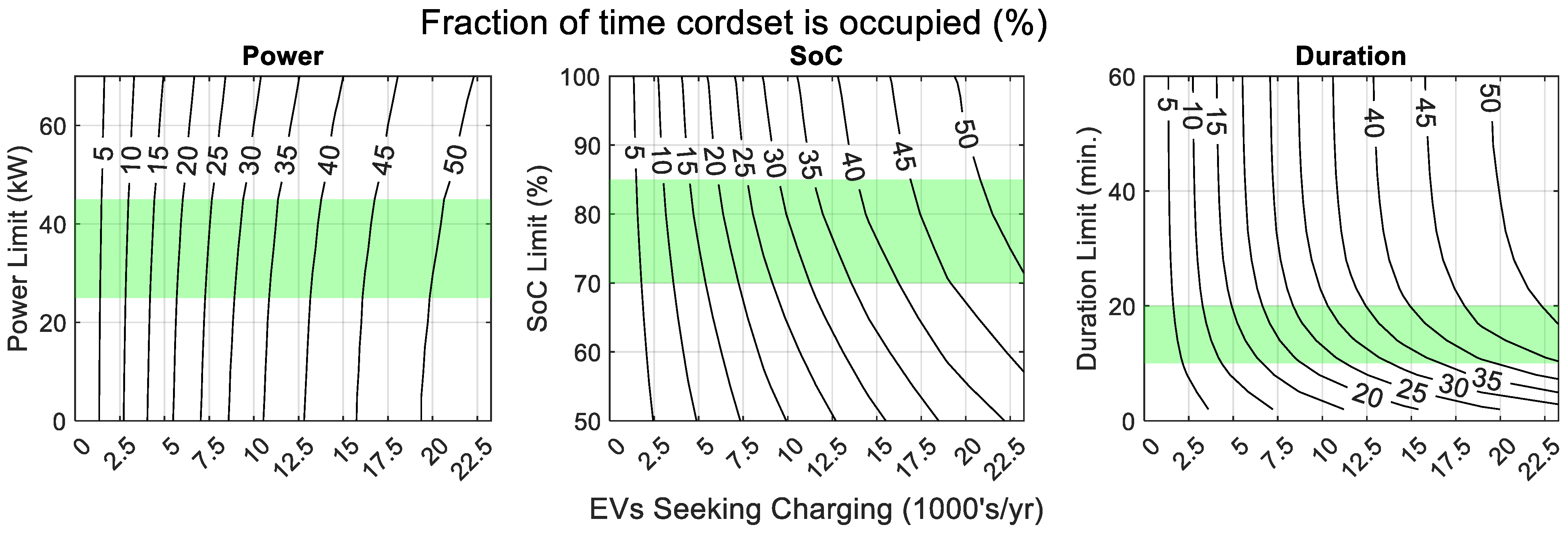
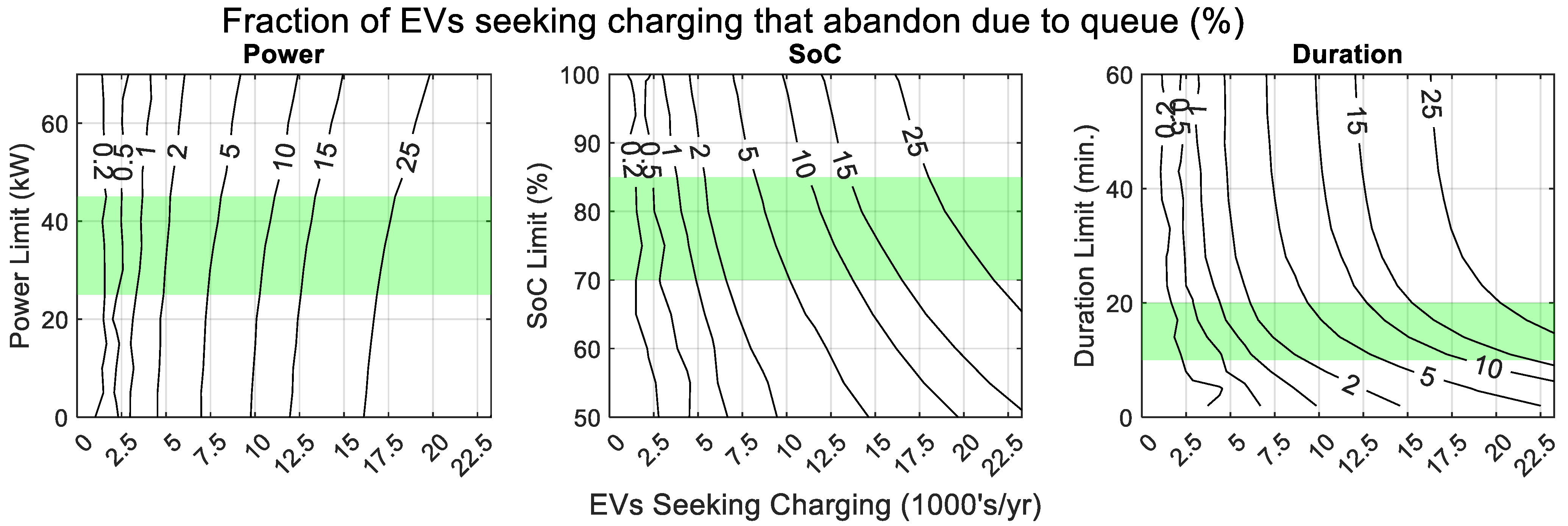
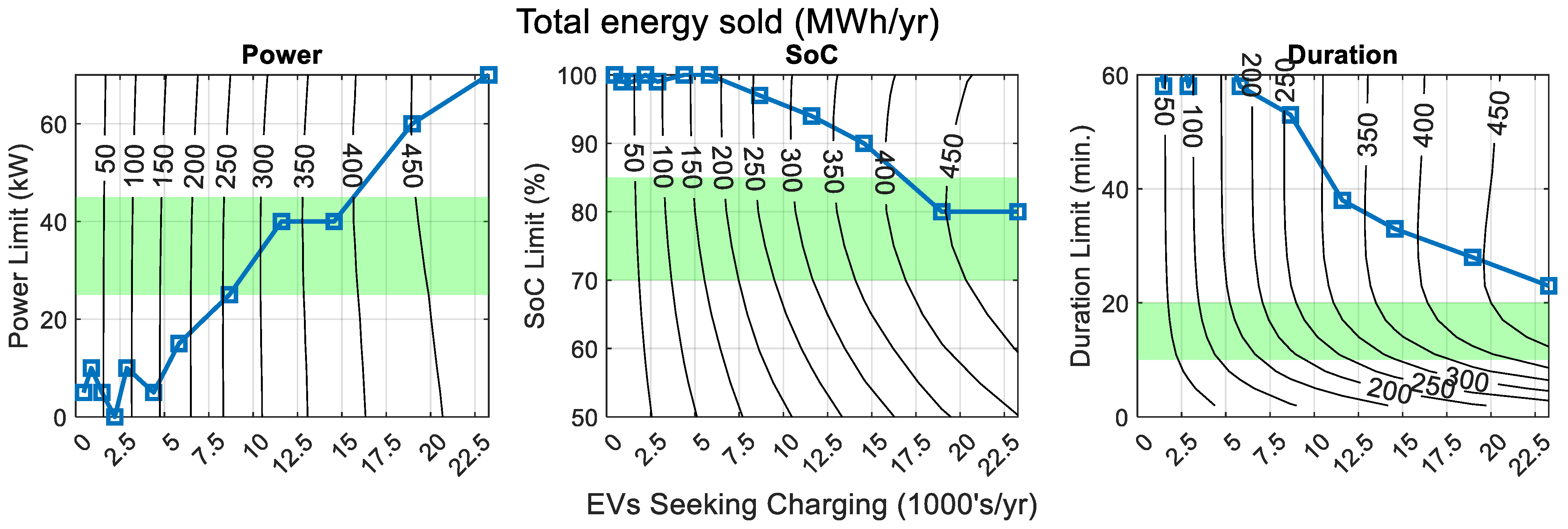


| Battery Type | Group Capacity (kWh) | Observed Fraction (%) | Group Growth | Future Probability (%) |
|---|---|---|---|---|
| 1 | 38 | 5 | 0.5 | 2.1 |
| 2 | 53 | 7.5 | 0.65 | 4.3 |
| 3 | 67 | 25.8 | 0.75 | 16.9 |
| 4 | 75 | 21.7 | 1 | 18.9 |
| 5 | 85 | 27.1 | 1 | 23.7 |
| 6 | 90 | 4.7 | 1 | 4.1 |
| 7 | 106 | 6 | 4 | 21.1 |
| 8 | 126 | 2.1 | 4 | 7.2 |
| 9 | 226 | 0.1 | 16 | 1.7 |
Disclaimer/Publisher’s Note: The statements, opinions and data contained in all publications are solely those of the individual author(s) and contributor(s) and not of MDPI and/or the editor(s). MDPI and/or the editor(s) disclaim responsibility for any injury to people or property resulting from any ideas, methods, instructions or products referred to in the content. |
© 2025 by the authors. Published by MDPI on behalf of the World Electric Vehicle Association. Licensee MDPI, Basel, Switzerland. This article is an open access article distributed under the terms and conditions of the Creative Commons Attribution (CC BY) license (https://creativecommons.org/licenses/by/4.0/).
Share and Cite
Pearre, N.; Jayanath, N.; Swan, L. Evaluating Unplug Incentives to Improve User Experience and Increase DC Fast Charger Utilization. World Electr. Veh. J. 2025, 16, 623. https://doi.org/10.3390/wevj16110623
Pearre N, Jayanath N, Swan L. Evaluating Unplug Incentives to Improve User Experience and Increase DC Fast Charger Utilization. World Electric Vehicle Journal. 2025; 16(11):623. https://doi.org/10.3390/wevj16110623
Chicago/Turabian StylePearre, Nathaniel, Niranjan Jayanath, and Lukas Swan. 2025. "Evaluating Unplug Incentives to Improve User Experience and Increase DC Fast Charger Utilization" World Electric Vehicle Journal 16, no. 11: 623. https://doi.org/10.3390/wevj16110623
APA StylePearre, N., Jayanath, N., & Swan, L. (2025). Evaluating Unplug Incentives to Improve User Experience and Increase DC Fast Charger Utilization. World Electric Vehicle Journal, 16(11), 623. https://doi.org/10.3390/wevj16110623






